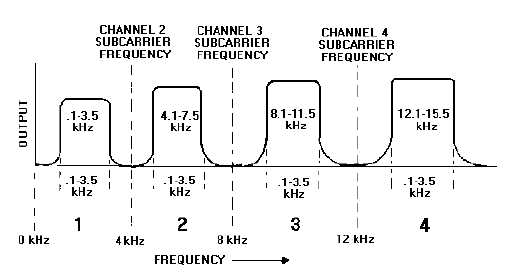3-33
Common methods of time-division multiplexing include PULSE AMPLITUDE MODULATION
(pam), PULSE WIDTH or PULSE DURATION MODULATION (pwm or pdm), PULSE POSITION
MODULATION (ppm), and PULSE CODE MODULATION (pcm). We have been studying an example
of pulse amplitude modulation. (These methods of tdm were discussed in NEETS, Module 12,
Modulation Principles.)
FREQUENCY DIVISION.—Frequency division multiplexing (fdm), unlike tdm, transmits and
receives for the full 360 degrees of a sine wave. Fdm used presently by the Navy may be divided into two
categories. One category is used for voice communications and the other for tty communications.
The normal voice speaking range is from 100 to 3,500 hertz. During single channel AM voice
communications, the audio frequency amplitude modulates a single rf (carrier frequency). However, in
voice fdm, each voice frequency modulates a separate frequency lower than the carrier frequency
(subcarrier frequency). If these subcarrier frequencies are separated by 3,500 hertz or more, they may be
combined in a composite signal. This signal modulates the carrier frequency without causing excessive
interference.
In figure 3-30, the output of channel one is the voice frequency range of 100 to 3,500 hertz. The
output of channel two is the combination of a different voice frequency with a subcarrier frequency of
4,000 hertz. The output of channel three is another voice frequency. This voice frequency combined with
a subcarrier frequency of 8,000 hertz gives you an output frequency range of 8,100 to 11,500 hertz. The
overall bw for the composite modulation package shown is 100 to 15,500 hertz. Each separate channel
occupies its own band of frequencies. The composite signal is used to modulate the carrier frequency of
the transmitter.
Figure 3-30.—Block diagram of a frequency-division multiplexing system.
Multichannel broadcast and ship/shore terminations use tty fdm. With this system, each channel of
the composite tone package of the broadcast is assigned an audio frequency. By multiplexing tty circuits,
up to 16 circuits may be carried in any one of the 3,000 hertz multiplexed channels described above.
Don't confuse the two types of multiplexing. In the first case, 3,000 hertz audio channels have been
combined. In the second case, a number of dc tty circuits are converted to tone keying and combined in a
single 3,000-hertz audio channel. Figure 3-31 illustrates a 16-channel, tty-multiplexing system. The
output of the dc pulsed circuits is converted to audio keying. Each channel has a separate audio center
frequency. Channel frequencies range from 425 hertz for the lowest channel to 2,975 hertz for the highest

